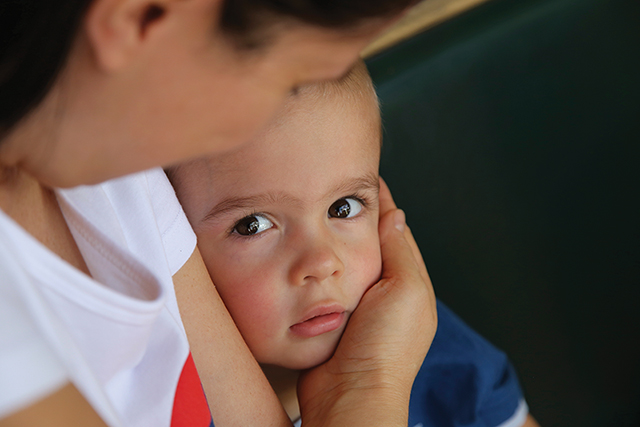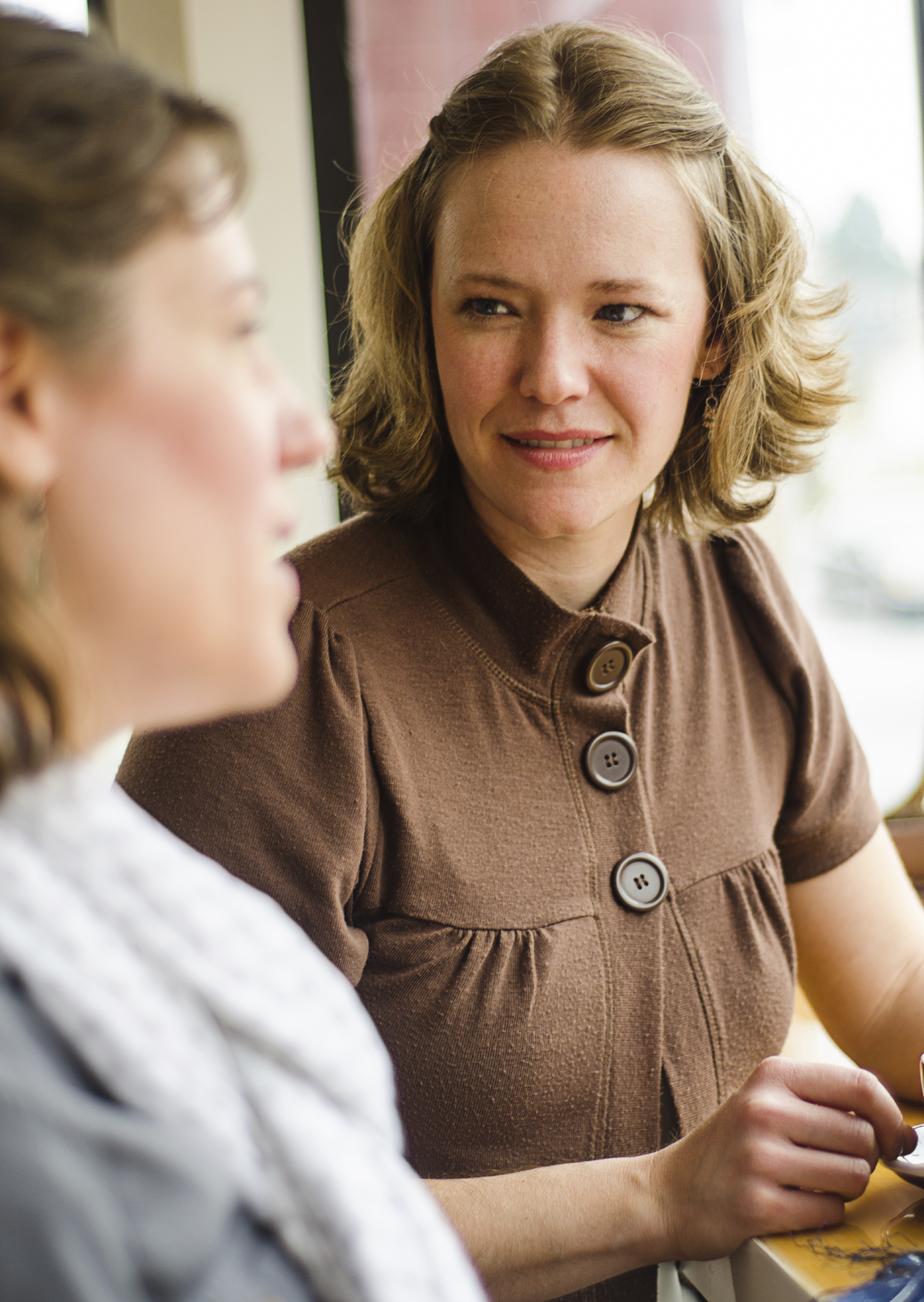This story reflects the case, but details have been changed to protect the privacy of the family.
I was greeted warmly by Mom, who was referred through her family doctor for infant mental health services because of concerns about her depression following the complicated birth of her son five months earlier. This was all the information I was given about the family, and I did not know what to expect when I arrived at the home that first day. The baby wasn’t home, having been sent over to Grandma’s so we would be free to speak together. Mom reported that she was becoming more depressed since the birth; being a mother wasn’t the joyful experience she had anticipated.
A Ship Off Course
She explained that the problem was her infant’s stubborn temperament. “He tantrums like a toddler.” Since the birth “I’ve been thinking that if he is this strong-willed at 3 weeks, what’s he going to be like when he goes to school?” She went on to say, “Now at 5 months, he doesn’t want certain people at certain times.” “He doesn’t want my attention. When I try to play with him he closes his eyes and goes to sleep, like he doesn’t want to see me.” When they are out in public and people come over to greet him, “He closes his eyes. He’s so disrespectful!”
Also, Mom explained, Baby wouldn’t stop crying and no one, not even the doctors, could figure out how to help. They had changed his formula several times. Now, Mom was told, “He’ll just have to grow out of it.” Mom showed great concern that if things weren’t taken care of soon, her son would be unbearable by the time he got to kindergarten. She felt she had to get a handle on the situation so he “wouldn’t always want things his own way.”
My first thought was, “This is a perfect infant mental health case!” My second thought was, “Oh, my gosh! These problems are so big and I’m so little! How will I ever be enough? I can’t possibly help in time to make a difference!”
Like a ship off course, their future looked uncertain. Both Mom and I could see that without something changing, their ship was headed for an iceberg. Here she was, inviting me to get on board and help her navigate these waters, but I wasn’t sure that I could offer enough help to get them on course. I had a sinking feeling; this case seemed so complex. How would I know what to do?
Mentors in my Pocket
I have a habit of noticing, before visits, that I have my mentors in my pocket, and this served me well. I heard the voice of Bill Shafer: “Just breathe and center yourself. Be present.” Then the voice of Michael Trout, “All you need to do is to listen carefully to her story. It will tell you all you need to know.” Doug Davies: “Let’s just watch.” Deborah Weatherston chimed in, “It’s the relationship.” And then I remembered that I wasn’t alone with this work. I have a Reflective Supervision group with Joan Shirilla.
Wrong Course Coordinates
It was painful to listen to Mom’s struggle to understand her infant’s behaviors, but as I did, I realized that the map she had been provided was skewed. She described how the hospital nursery staff had labeled her baby on several occasions, even at good-bye, as “Stubborn.” She also remembered the pediatrician calling her infant “stubborn.” Not knowing much about babies, Mom took the experts at their word. Here she was, trying so hard to understand her baby and their journey together, but she had been given the wrong course coordinates.
The Presence of the Baby
Baby was present at our next visit. He was a handsome but frail-looking infant, with a head full of wispy hair. His clothes were carefully chosen and he appeared to be well cared for. He sat scrunched into an infant seat near his mother’s chair, and I felt a loneliness when I observed him attempting to bat at toys hanging on a rod in front of him. When I entered the room he stilled and stared. I didn’t see him reference his mother for support. After a time he grew fussy and Mom picked him up. But he had a hard time getting settled when his mother tried to hold and comfort him. I sensed that neither of them felt a sense of calming comfort in the interaction, with Mom juggling him into multiple positions to try to find just the right one.
Many Stories Told
With her baby in her arms, I heard more of their story — the unexpected nature of the pregnancy, their harrowing birth experience, and the challenges they faced at the hospital after the birth. Mom had sometimes dreamed about having a baby but thought that she never would become pregnant because of her endometriosis, and she had put the idea out of her mind. She went to the doctor after feeling unwell, thinking it was related to some illness, and tested positive for this pregnancy. She was considered high-risk due to numerous medical issues and was monitored closely. They expected Baby to be born prematurely and with special needs because Mom had to remain on certain medications throughout the pregnancy.
Contractions at 26 weeks led to a period of bed rest for Mom, who remained fearful she couldn’t keep her baby inside to term. When the contractions came again, Baby was delivered by C-section at 36 weeks. There were a multitude of people in the room to observe the procedure. Mom related she believed that they were there because it was such a high- risk delivery, and that the staff thought that either Mom or Baby would die in the process. She was frightened about the procedure, worried that either she or her baby “wouldn’t make it”. When he was delivered, he was quiet, and Mom had a difficult time being reassured that he was alive.
Mom and Baby stayed in the hospital for a few days. Mom had hoped to nurse, but she related that Baby only wanted to sleep and was not interested in her or the milk she had to offer. He often seemed “lazy” and wouldn’t open his mouth to eat. She told me the nurses all noticed what a stubborn baby he was, but one nurse accused Mom of underfeeding him and causing fussiness, so Baby’s feedings were taken from Mom for a night. Mom was distraught, worried her baby was starving, as he was not gaining weight like the hospital expected. His fussiness continued and nurses told Mom he was going to be trouble. They nicknamed him “Stubborn Baby” on the unit, per Mom, and said things like, “He’s going to be a stubborn one!”
At his newborn doctor’s visit, Baby held one arm out straight and didn’t withdraw it like the doctor thought he should. To check his reflexes he “dropped him a little bit” and he pulled his arm in. Mom told me the doctor said that “he was just being stubborn” by not moving his arm as he had wanted him to, and that he was capable of bending it, so everything was fine.
Daunting Challenges
The challenges Mom faced at home were so daunting that she relied night and day on her own mother and father for help with infant care. Whenever he was awake, Baby cried all the time, and Mom couldn’t find a way to comfort him or discover what was wrong, even though she wracked her brain to think of every possibility. She had tried several different sleep locations, but Baby didn’t seem to like any of them. In fact, the baby had spent only one night at home since his birth. Mom didn’t feel like Baby preferred anyone special and, in fact, sometimes worried that Baby even “hated” her. Even the neighbor, who had several children of her own, noted that this baby was not like other babies.
Mom made many assumptions about her baby’s behavior and temperament that showed me a bigger picture of the skewed map she was trying to follow. When Baby wouldn’t settle, Mom, Grandma and Grandpa would pass him around. When he would finally calm, they attributed it to his “liking” the person he was with at the time. Mom worried that Baby didn’t like her home, perhaps because of the dark interior and lack of windows in their tiny apartment. When Baby was fussy, he seemed to calm when they took a car ride to her parents’ larger country house. Mom attributed this to Baby knowing they were going to Grandma’s. Baby seemed to prefer holding his head to one side when he was in his infant seat. Mom tried to move his head around, so it wouldn’t become misshapen, but Baby was “stubborn” and kept repositioning himself, which Mom attributed to the same stubbornness he displayed at the doctor’s office.
In trying to understand her infant, Mom attributed manipulative intentions to most of Baby’s infant actions and reflexes. Through it all, I sensed Mom caring deeply about Baby. She maintained a persistent intention to figure him out using the only template she knew.
Watching and Wondering Together
Together we watched Baby carefully, to see what we might learn from him about his difficulties. As we looked, I recalled Mom’s stressful experience of her high-risk pregnancy and the frightening birth. I wondered aloud what things might have been like for Baby during the birth and neonatal period, and how stressed he, too, must have felt. Mom began to think about how she and Baby both shared the terrifying birth experience and were both confused about their entrances — Baby into the big world, and Mom into the world of motherhood. Together, we noticed some of the same signals Mom had noticed in the past, and that Baby was now giving, that suggest a baby is stressed. We spent a long time just watching and wondering together. I tried not to be in a hurry or provide answers that Mom might not yet be ready to hear, despite my urge to give her every pamphlet I had in the trunk of my car. Following the voices of my mentors, I reminded myself that everything would unfold in time, and that this mother knew inside of her how to help her baby. She had the curiosity and the will to do it, if we could explore what was blocking her efforts.
The Awakening
At the next visit, which was the Plan of Service required by our CMH infant mental health program to decide what goal and interventions we would use, I walked into a different household. Mom and Baby were chatting together, showing joy and delight in one another’s company. Baby was happy and full of life, and so was Mom. “He hasn’t cried in two weeks!” He had been sleeping at home every night. Mom now saw her baby as loving her and preferring her above all others, and she saw herself as her baby’s protector and soother. Mom stated that she realized that all of the attributes she had been giving Baby were actually her misreading her baby’s signs of stress, and, as a mom, it was her job to protect her baby from stress. And so she was.
Mom indicated that now, when she first notices Baby is getting tired, she picks him up and rocks him to sleep, because if she doesn’t, Baby only becomes more and more upset. Grandma was incredulous that Mom was able to tell what her baby needed, just by looking at him, but Mom stated, “I just know!” Mom shared many other triumphs when she successfully protected her baby from feeling over-stressed, and Baby’s changes in temperament and behavior that followed. In crowded stores she now carried Baby so he would feel secure in a strange and noisy place. Baby no longer cried on outings, would greet strangers who came up to him when he was in Mom’s arms, and would look people in the eye. It seems Mom now heard Baby’s cries as “I need you” rather than as “I hate you.”
Maps for Sailing to Sunnier Climes
As we were to start the “intervention” stage of our work together, Mom phoned to tell me she had been evicted from the apartment and had moved out of county. She thanked me for our time together. “Thank you so much for your help. Without this help I never would have known my Baby really loves me.” After only three encounters, I had to disembark. But just like making a small course correction at the beginning of a journey may lead a ship to make port in Tahiti instead of Antarctica, I am hopeful this dyad will be sailing to sunnier climes.
Remembering back to how small and alone I felt at first, I feel so grateful for the maps I was given to guide my way through the mentorship of those who have sailed these seas. Because somehow, all of us together, we were enough.





